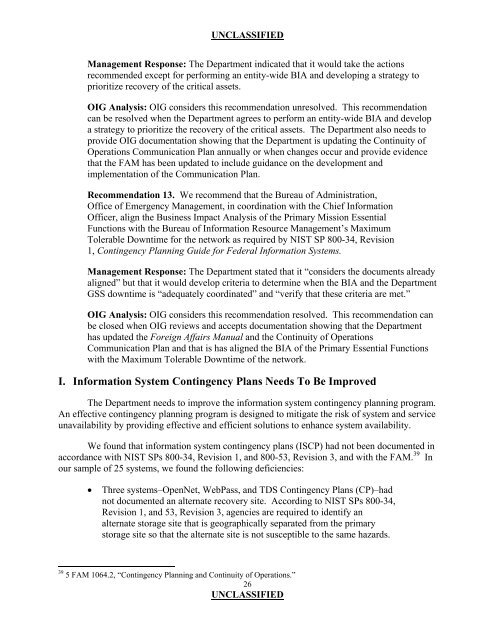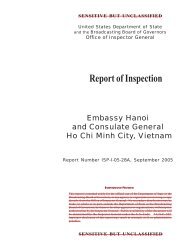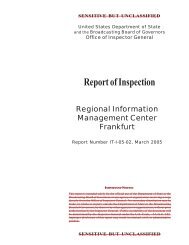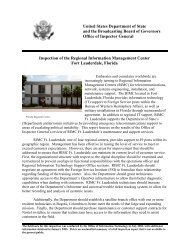Evaluation of Department of State Information Security Program ...
Evaluation of Department of State Information Security Program ...
Evaluation of Department of State Information Security Program ...
You also want an ePaper? Increase the reach of your titles
YUMPU automatically turns print PDFs into web optimized ePapers that Google loves.
UNCLASSIFIED<br />
Management Response: The <strong>Department</strong> indicated that it would take the actions<br />
recommended except for performing an entity-wide BIA and developing a strategy to<br />
prioritize recovery <strong>of</strong> the critical assets.<br />
OIG Analysis: OIG considers this recommendation unresolved. This recommendation<br />
can be resolved when the <strong>Department</strong> agrees to perform an entity-wide BIA and develop<br />
a strategy to prioritize the recovery <strong>of</strong> the critical assets. The <strong>Department</strong> also needs to<br />
provide OIG documentation showing that the <strong>Department</strong> is updating the Continuity <strong>of</strong><br />
Operations Communication Plan annually or when changes occur and provide evidence<br />
that the FAM has been updated to include guidance on the development and<br />
implementation <strong>of</strong> the Communication Plan.<br />
Recommendation 13. We recommend that the Bureau <strong>of</strong> Administration,<br />
Office <strong>of</strong> Emergency Management, in coordination with the Chief <strong>Information</strong><br />
Officer, align the Business Impact Analysis <strong>of</strong> the Primary Mission Essential<br />
Functions with the Bureau <strong>of</strong> <strong>Information</strong> Resource Management’s Maximum<br />
Tolerable Downtime for the network as required by NIST SP 800-34, Revision<br />
1, Contingency Planning Guide for Federal <strong>Information</strong> Systems.<br />
Management Response: The <strong>Department</strong> stated that it “considers the documents already<br />
aligned” but that it would develop criteria to determine when the BIA and the <strong>Department</strong><br />
GSS downtime is “adequately coordinated” and “verify that these criteria are met.”<br />
OIG Analysis: OIG considers this recommendation resolved. This recommendation can<br />
be closed when OIG reviews and accepts documentation showing that the <strong>Department</strong><br />
has updated the Foreign Affairs Manual and the Continuity <strong>of</strong> Operations<br />
Communication Plan and that is has aligned the BIA <strong>of</strong> the Primary Essential Functions<br />
with the Maximum Tolerable Downtime <strong>of</strong> the network.<br />
I. <strong>Information</strong> System Contingency Plans Needs To Be Improved<br />
The <strong>Department</strong> needs to improve the information system contingency planning program.<br />
An effective contingency planning program is designed to mitigate the risk <strong>of</strong> system and service<br />
unavailability by providing effective and efficient solutions to enhance system availability.<br />
We found that information system contingency plans (ISCP) had not been documented in<br />
accordance with NIST SPs 800-34, Revision 1, and 800-53, Revision 3, and with the FAM. 39 In<br />
our sample <strong>of</strong> 25 systems, we found the following deficiencies:<br />
� Three systems–OpenNet, WebPass, and TDS Contingency Plans (CP)–had<br />
not documented an alternate recovery site. According to NIST SPs 800-34,<br />
Revision 1, and 53, Revision 3, agencies are required to identify an<br />
alternate storage site that is geographically separated from the primary<br />
storage site so that the alternate site is not susceptible to the same hazards.<br />
39<br />
5 FAM 1064.2, “Contingency Planning and Continuity <strong>of</strong> Operations.”<br />
26<br />
UNCLASSIFIED








